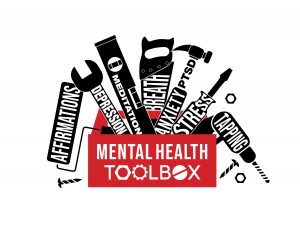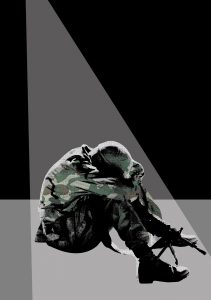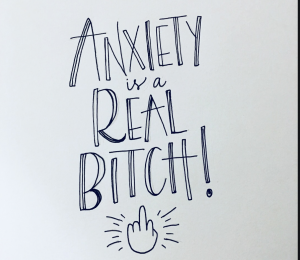These past couple of years have been a bit different to say the least. Now on top of coming out of a pandemic, we are witnessing a war — watching, listening, and seeing the horrific things going on in the Ukraine can have a negative impact on your mental health. First, let’s take a look at how war has changed in the media. During World War I, the media consisted of radio and newspapers, and World War II added newsreels which were viewed at the movie theater kept folks up to date of “our boys” across the sea. By the time Vietnam and The Korean War came around, the media had expanded to include television which brought what war really looked like into our living rooms. I remember as a child watching Walter Cronkite as he explained what was going on, seeing the imagery, and watching the reporters as Saigon fell. I remember watching the soldiers and sailors come home from Vietnam; seeing their families run up and hug them. When the Gulf War came about, viewing war was even more accessible due to the latest technological advancements of the internet and email. Soldiers, Sailors, Airmen, Marines could directly communicate via email to their families and tell them what they were experiencing and witnessing first hand. Further was the use of satellite phones (before cell phones) that could be used to call home. As the wars progressed forward, more technology was becoming available and people could actually go on a computer and look at news being shared from around the world. The adoption of personal cell phones in the 90’s greatly increased our levels of exposure and now that smartphones are ubiquitous we have the entire power of the global world wide web at our fingertips.. Starting with Afghanistan and now with Ukraine, we can watch what’s going on 24 hours a day, 7 days a week in real time. Even if you don’t “doom scroll,” one cannot avoid being a direct witness to this war. The exposure is constant, but how does the body handle it?
It is true that you can be traumatized by watching, listening, and seeing images of war – the haunting images can alter our immediate realities and also our connection to our pasts.
In 2019, the National Institute of Health (NIH) wrote an article, “Can you get PTSD/Trauma by watching TV?” They concluded, “TV viewing following trauma exposure may be a marker of vulnerability for developing PTSD and also a consequence of having PTSD. High TV viewing levels may be linked with ineffective coping strategies or social isolation, which increase risk of developing PTSD” (https://www.ncbi.nlm.nih.gov/pmc/articles/PMC6428392/).
Which leads me to consider how trauma, stress, and anxiety from witnessing war in the media manifest and show up in the body. While an official diagnosis from a doctor is imperative, one can keep an eye out for the following:
- Sleep Issues – lying in bed at night not being able to sleep
- Constant urge to check your phone, watch the news, and be in touch with what’s going on
- Not wanting to do your favorite hobbies
- Reliving what you watched over again in your head
- Anxiousness – What if the war comes here? What if we go to war? What if there’s a draft?
- Restless and Agitated
- Fatigue and Exhaustion
- Frequent Headaches
- Irritable
- Drinking alcohol more than usual or using recreational drugs
- Gut/bowel issues
- Changes to blood pressure and heart beat
- Lack of sex drive – yes! Long term stress, anxiety, and trauma (and depression too) can cause a lack of sex drive!
This is just a short list of common symptoms.
There are a few simple things you can do to combat the information overload:
- Pay attention to the amount of time spent on your phone, what you’re looking at and when. Turn off any and all alerts that can wake you through the night and set a curfew by when you will stop looking at your phone. My curfew happens to be 8pm.
- Second, stop or limit your watching the news. That’s probably a tough one. Not that I’m against the news nor do I feel we should be ignoring what is going on as a matter of fact, the opposite. As I read in the New York Times recently, “The best photographs of war might make us want to look away. It’s imperative that we do not.” But the consumption must be contained. Witnessing war in the evening can cause stress which makes falling asleep might be harder because of what you’ve witnessed – you can also suffer from nightmares and eating while watching the news can cause digestion issues.
- Get out. Go for a walk. Even if it’s just around the block or down the street, getting out in nature can really help with your overall outlook in life.
- Exercise— I am not talking about running 5 miles. The exercise can be as simple as lifting cans of beans to getting a membership at a gym. Yoga is also a great way to reduce anxiety and relieve stress. The American Osteopathic Association wrote a great article about how yoga helps with mental health. Natalie Nevins, DO out of Hollywood states:
Aside from the physical benefits, one of the best benefits of yoga is how it helps a person manage stress, which is known to have devastating effects on the body and mind. “Stress can reveal itself in many ways, including back or neck pain, sleeping problems, headaches, drug abuse, and an inability to concentrate,” says Dr. Nevins. “Yoga can be very effective in developing coping skills and reaching a more positive outlook on life.”
Yoga’s incorporation of meditation and breathing can help improve a person’s mental well-being. “Regular yoga practice creates mental clarity and calmness; increases body awareness; relieves chronic stress patterns; relaxes the mind; centers attention; and sharpens concentration,” says Dr. Nevins. Body- and self-awareness are particularly beneficial, she adds, “because they can help with early detection of physical problems and allow for early preventive action.”
Some of my favorite poses (which can be done in a chair too) to help me regroup and reset go like this:
-
- Standing nice and tall, roll the shoulders up and back. Inhale the arms overhead, then exhale them forward fold,
- Inhale the hands to the shins, exhale them back to the floor,
- Walk the feet back to plank (top of a pushup). If you’re using a chair, you can do a plank using the chair,
- Take a deep breath, and as you exhale bring the entire body to the floor. If you’re in a chair, just stay in the plank position.
- Inhale, lift the chest and head up to cobra, exhale down. If you’re in a chair, stay in plank.
- Tuck your toes in, inhale, and lift your buttocks into downward facing dog. You can do this with the chair too. Just lift your buttocks and walk in your feet a little.
- As you exhale, walk your feet towards your hands. Inhale the hands to the shins and exhale them back to the floor.
- Inhale the arms up in the air, lift the torso too and as you exhale bring the hands to the heart. You can do this as many times as you feel necessary.
- Meditation is an amazing way to help with dealing with stress, anxiety, and trauma (and depression too!). There are over 20+ types of meditation out there. So many have come to me telling me they “can’t meditate.” If you are one of those people, you just haven’t found a type of meditation that you liked. People who have anxiety, depression, trauma, and stress typically do better with using a mantra/word or saying type of meditation. Samoon Ahmad, MD is a Clinical Professor of Psychiatry, NYU Grossman School of Medicine; Unit Chief, Inpatient Psychiatry, Bellevue Hospital Center; and Founder of Integrative Center for Wellness in New York City who wrote an article for Psychology Today. He states, “Meditation, particularly mindful meditation, teaches those who practice it to focus on the present moment, breath by breath. Suzanne Westbrook, a retired internal medicine doctor at Harvard, describes it as a means of “noticing what happens moment to moment, the easy and the difficult, and the painful and the joyful. It’s about building muscle to be present and awake in your life.” My dear friend, the Venerable Bhante Sujatha from the Blue Lotus Temple in Chicago says, “The world is too big to change, but you are big enough to change yourself.” If you’re new to meditation, you can start off by using an app like Calm, Insight Timer, or 10% Happier. There are quite a few apps out there for meditation so play around and see what works for you. If you’re on a budget, Insight Timer and Calm have free portions you can use over and over again. If you’re not an app person and want to try on your own, you can use the Loving Kindness Meditation which is extremely simple, “I am Happy. I am Healthy. I am at Peace.”
Here is a great sample 15-minute mindfulness meditation:
- A breathing (which I know some of you are saying, “huh?) practice is a fabulous and simple way of working through anxiety, depression, PTSD/trauma, and stress. From three part breathing to 4-7-8 breathing to box breathing, there are quite a few different practices to try.
Three-part breathing (or diaphragmatic breathing) starts at the belly and works your way up to the thoracic and cervical areas.
4-7-8 breathing is super simple too. Inhale for 4 seconds, hold for 7 seconds, and exhale for 8 seconds. You can do this 5 – 8 times.
Box breathing is another simple one. This is also taught in the military. Inhale for 4 seconds, hold for 4 seconds, exhale for 4 seconds, hold for 4 seconds. Like 4-7-8 breathing, you can do this 5 – 8 times. - Boundaries are important when it comes to your exposure too. Oftentimes individuals will want to talk about what’s going on out in the world. If you find these conversations are challenging for you because of the content, walk away, ask your party to change the subject, or leave.
All these things are easy, simple, and free or of little cost. You don’t need to spend an extravagant amount of money to help yourself. There are so many things on the internet that can aid you too. YouTube has great meditations and calming music. So does Apple and Spotify if you use them.
I’ve personally been through three or four wars; from watching them on tv as a child to participating in them as a former military member, I’ve been targeted in active war zones and experienced unrest in foreign countries. I know what it’s like to live with some level of PTSD day in and day out and it is no picnic — but it is manageable.
All of the tactics I mentioned above I do each and every day. When I wake up, while my tea is steeping, I meditate for 5 minutes. I do my daily yoga practice in the morning before I shower and, in the afternoon, I take a walk with my dog. In the evening, I do another meditation practice and a breathing practice before I go to bed. These practices, as simple as they are, when done consistently work to lower my stress and anxiety and I’m always looking for new and different ways to help others work to lower their anxiety, depression, PTSD/Trauma, and stress – whether they realize they even have it or not. If you’re constantly witnessing war, it is quite likely your mental health is being affected by it. Take the time for yourself and help your mental wellness to be at its best.
####
Cindy Beers, MS 500ERYT is a Mental Health Yoga Instructor and Service Disabled Veteran based out of Harrisburg, PA.







